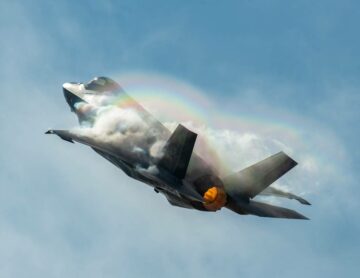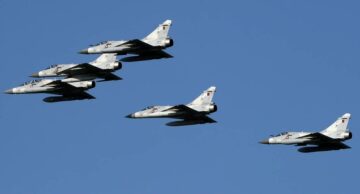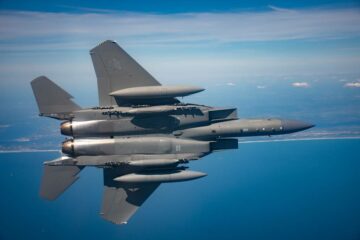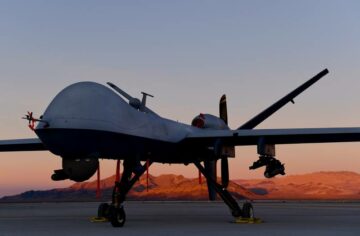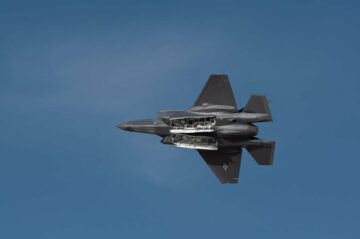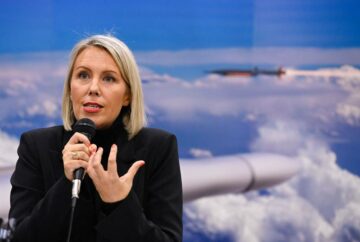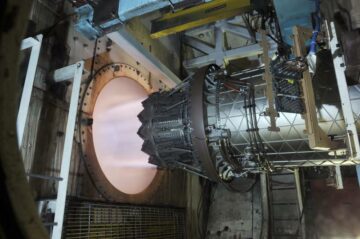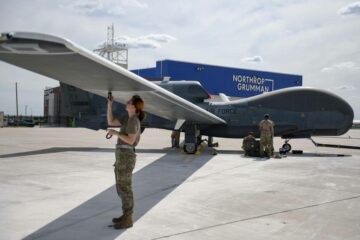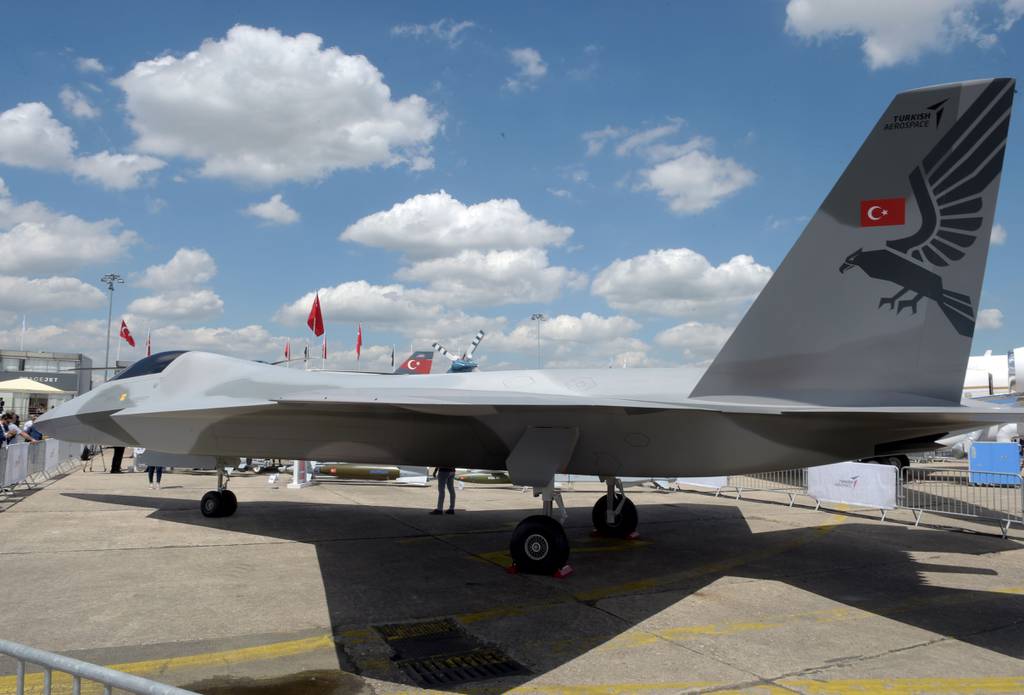
ANKARA, Turkey — The first aircraft of Turkey’s indigenous fighter program, the TF-X, sits in a hangar ahead of its maiden flight at the end of the year. But fiscal problems could stand in the way of its success, according to an analyst, even as the country’s president seeks partners for the program.
The Turkish economy is experiencing high inflation, and the country’s external debt reached nearly $476 billion in March. The international insurance company Allianz Trade reported the stock of total external debt due within the next 12 months has risen to about $250 billion.
“Inevitably, the TF-X program will face financial difficulties in line with the country’s economic situation,” Ozgur Eksi, a defense analyst in Ankara, told Defense News.
However, Turkey is seeking foreign partners, which could lessen its own financial burden in regard to the program.
Turkish Defence Minister Yasar Guler said Aug. 14 Pakistan was about to sign an agreement to participate in the development of the fifth-generation fighter. “Friendly and brotherly countries are also making efforts to become partners in this project. An agreement was signed with Azerbaijan. There are other countries that are also about to sign, like Pakistan,” Guler said.
If Pakistan joins the Turkish program, it would be its second international fighter partnership following a deal with China on the JF-17 built by Pakistan Aeronautical Complex and Chengdu Aircraft Corp.
As for Azerbaijan, the government there signed a protocol with Turkey to explore involvement in the TF-X program.
“With the protocol, it is aimed to determine the working procedures and principles of cooperation with Azerbaijan on joint production issues, including the development activities of the 5th-generation national combat aircraft Kaan, which is being developed for the Turkish Air Force,” according to the Turkish Defence Industry Agency, using the government’s chosen name for the TF-X aircraft.
The agency, otherwise known as SSB, did not reply to Defense News’ questions on the TF-X and specifically Pakistan’s current status in relation to the program.
The Pakistan Air Force declined to comment on the status.
“Getting in foreign partners is like subletting part of your house: You share expenses, but disputes become inevitable and troubleshooting takes much longer than normal,” Eksi said. “Hydrocarbon-rich Azerbaijan has money. Pakistan does not but could transfer know-how. Once combat-proven, the Kaan could be an option for countries without access to Western-made fighter aircraft.”
Eugene Kogan, a defense analyst based in Tbilisi, Georgia, said Azerbaijan appears ready to bring money to the table.
“As for Pakistan, I wonder what exactly it can bring to the table. Not money, obviously. Technological know-how? More questions than answers,” he told Defense News.
Future flight
The government wants to fly the planned aircraft this year, the centennial of the Turkish republic. Turkish Aerospace Industries said the TF-X will fly Dec. 27, 2023.
Under the program, TAI will deliver 20 TF-X Block 10 aircraft to the Air Force in 2028. The company said in March the per-unit price will be $100 million, but noted in May it could be “a little bit higher.” By 2029, TAI plans to produce two TF-X fighters per month, generating an annual revenue of $2.4 billion.
“In all probability, the aircraft will fly for political purposes before critical local elections [in March] but without most systems fitted into it,” a program insider told Defense News on the condition of anonymity, fearing prosecution for discussing the subject. “Most Turks will not know or care if the aircraft is ready for any mission. It will be a piece in [the] government’s showoff.”
Turkey launched the TF-X program in 2009. In October 2016, British firm Rolls-Royce offered a joint production partnership to Turkey with a view to powering planned Turkish platforms and potential sales to third parties. The company’s proposal, which still stands, would see a production unit in Turkey manufacture engines for the TF-X as well as helicopters, tanks and missiles.
In January 2017, the British company BAE Systems and TAI signed a deal worth more than £100 million (U.S. $127 million) to develop the Turkish fighter jet. Presently there are about 30 BAE engineers working at the TAI production unit for the TF-X.
Then in 2022, the Turkish government launched a competition for the local development of a turbofan engine to power the TF-X. Three competitors are in the running: Tusas Engine Industries; TRMotor; and TAEC, a joint venture between Rolls-Royce and Turkish industrial conglomerate Kale, which owns 51% of TAEC.
TAEC has pitched an engine expected to fly the aircraft at a maximum altitude of 40,000 feet and help it reach a speed of up to Mach 1.8.
It’s unclear what TRMotor is offering. The company was founded in 2017 by SSTEK, a subsidiary of SSB. Tusas, which is the parent company of Tusas Engine Industries and Turkish Aerospace Industries, wholly owns TRMotor.
Tusas Engine Industries is developing TEI-TF6000 and TEI-TF10000 engines, referring to them as a prelude to what it will produce for the TF-X. TEI is a government-controlled business founded in 1985 as a joint venture involving the American firm GE Aviation (now GE Aerospace), Turkish Aerospace Industries, the Turkish Aeronautical Association, and the government-owned Turkish Armed Forces Foundation.
SSB plans to build TF-X prototypes using the American-made F110 engine. The General Electric F110 is an afterburning turbofan jet engine produced by GE Aerospace, and it uses the same engine core design as the company’s F101. The engine is also built under license by Tusas Engine Industries.
Turkey wants to use the F110 in serial production, but powering the TF-X with the engine may prove difficult because serial production could require vast amounts of investment and tests. Furthermore, this option would come with the same export license and intellectual property rights as Rolls-Royce’s offer, which the Turkish government dislikes.
Eksi said the government shouldn’t delay its engine choice any longer.
“Every [engine] proposal has advantages and disadvantages. Ankara must make a decision at once before it’s too late to move onto the serial production phase at feasible costs,” he explained.
Ultimately, the TF-X’s export potential is key to the program’s success, Eksi added.
“There are several countries that cannot buy Western-made aircraft for political reasons. Some of those countries also want to avoid Russian- or Chinese-made aircraft, also for political reasons. The Kaan could be what they’re looking for.”
Usman Ansari in Islamabad contributed to this report.
Burak Ege Bekdil is the Turkey correspondent for Defense News.
- SEO Powered Content & PR Distribution. Get Amplified Today.
- PlatoData.Network Vertical Generative Ai. Empower Yourself. Access Here.
- PlatoAiStream. Web3 Intelligence. Knowledge Amplified. Access Here.
- PlatoESG. Automotive / EVs, Carbon, CleanTech, Energy, Environment, Solar, Waste Management. Access Here.
- PlatoHealth. Biotech and Clinical Trials Intelligence. Access Here.
- ChartPrime. Elevate your Trading Game with ChartPrime. Access Here.
- BlockOffsets. Modernizing Environmental Offset Ownership. Access Here.
- Source: https://www.defensenews.com/air/2023/08/31/turkey-seeks-partners-for-tf-x-fighter-program-amid-fiscal-uncertainty/
- :has
- :is
- :not
- $100 million
- $UP
- 000
- 1
- 10
- 12
- 12 months
- 14
- 1985
- 20
- 2009
- 2016
- 2017
- 2022
- 2023
- 2028
- 27
- 30
- 40
- 70
- 8
- 9
- a
- About
- access
- According
- activities
- added
- advantages
- Aerospace
- After
- agency
- Agreement
- ahead
- aimed
- AIR
- Air Force
- aircraft
- All
- also
- American
- Amid
- amounts
- an
- analyst
- and
- annual
- ANNUAL REVENUE
- Anonymity
- answers
- any
- ARE
- armed
- Art
- AS
- Association
- At
- Aug
- aviation
- avoid
- BAE Systems
- based
- BE
- because
- become
- before
- being
- between
- Billion
- Bit
- bring
- British
- build
- built
- burden
- business
- but
- buy
- by
- CAN
- cannot
- care
- Checks
- China
- choice
- chosen
- combat
- come
- comment
- company
- Company’s
- competition
- competitors
- complex
- condition
- conglomerate
- contributed
- cooperation
- Core
- Corp
- Costs
- could
- countries
- country’s
- critical
- Current
- deal
- Debt
- decision
- defence
- Defense
- delay
- deliver
- Design
- Determine
- develop
- developed
- developing
- Development
- DID
- difficult
- difficulties
- discussing
- disputes
- does
- due
- Economic
- economy
- efforts
- Elections
- Electric
- end
- Engine
- Engineers
- Engines
- Even
- exactly
- expected
- expenses
- experiencing
- explained
- explore
- export
- external
- Face
- feasible
- Feet
- financial
- Firm
- First
- Fiscal
- flight
- following
- For
- Force
- Forces
- foreign
- Foundation
- Founded
- Furthermore
- ge
- General
- General Electric
- generating
- Georgia
- Government
- he
- helicopters
- help
- High
- High inflation
- House
- HTML
- HTTPS
- i
- if
- image
- images
- in
- Including
- industrial
- industries
- industry
- inevitable
- inflation
- Insider
- insurance
- intellectual
- intellectual property
- International
- into
- investment
- involvement
- involving
- issues
- IT
- ITS
- January
- Joins
- joint
- joint venture
- jpg
- Key
- Know
- known
- Late
- launched
- License
- like
- Line
- little
- local
- longer
- looking
- make
- Making
- March
- maximum
- May..
- million
- minister
- missiles
- Mission
- money
- Month
- months
- more
- most
- move
- much
- must
- name
- National
- nearly
- news
- next
- normal
- noted
- now
- october
- of
- offer
- offered
- offering
- on
- once
- onto
- Option
- or
- Other
- otherwise
- own
- owns
- Pakistan
- parent company
- part
- participate
- parties
- partners
- Partnership
- per
- phase
- piece
- pitched
- planned
- plans
- Platforms
- plato
- Plato Data Intelligence
- PlatoData
- political
- potential
- power
- Powering
- presently
- president
- price
- principles
- probability
- problems
- procedures
- produce
- Produced
- Production
- Program
- project
- property
- Property Rights
- proposal
- PROSECUTION
- protocol
- prototypes
- Prove
- purposes
- Questions
- reach
- ready
- reasons
- regard
- relation
- reply
- report
- Republic
- require
- revenue
- rights
- Risen
- Rolls-Royce
- Run
- running
- s
- Said
- sales
- same
- Second
- see
- seeking
- Seeks
- serial
- several
- Share
- sign
- signed
- sits
- situation
- some
- specifically
- speed
- stand
- stands
- Status
- Still
- stock
- subject
- subsidiary
- success
- system
- Systems
- table
- takes
- Tanks
- tech
- technological
- test
- Test run
- tests
- than
- that
- The
- Them
- There.
- Third
- third parties
- this
- this year
- those
- three
- to
- too
- Total
- trade
- transfer
- Turkey
- Turkish
- two
- u.s.
- Uncertainty
- under
- unit
- use
- uses
- using
- Vast
- venture
- View
- want
- wants
- was
- Way..
- WELL
- What
- which
- wholly
- will
- with
- within
- without
- working
- worth
- would
- year
- you
- Your
- zephyrnet

